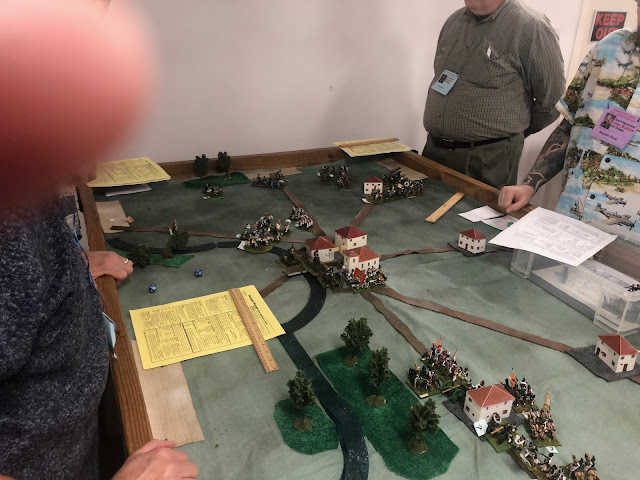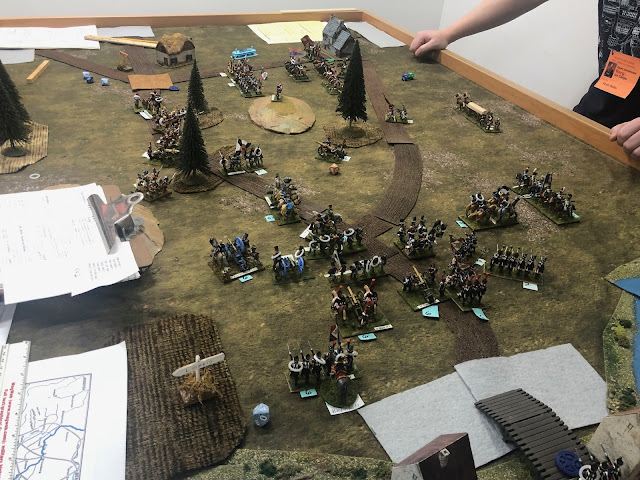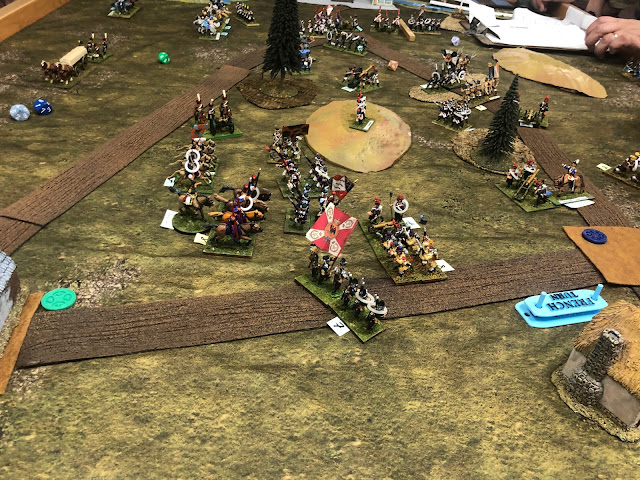Refueled by Pizza, the 1813 Campaign in a Day reaches its climax and resolution...
The continuing Battel of Wittenburg from the perspective of one wing of General Berg's Russian Corps.
and the other wing of Berg's Corps,. opposing part of Lauriston's Corps.
General von Bulow's constricted position and much diminished Prussian Corps outside of Leipzig.
The pace of the French advance quickens at Altenburg, where von Blucher, although heavily outnumbered, holds his own with some Russian support.
Overview of the involving Battle of Wittenburg; von Yock's position is rapidly destabilizing.

The French position around Leipzig.
The situation remains fluid at the Battle of Dresden.
"Man down!" The French Guard cavalry tries to polish off the rest of Von Bulow's men.
A charge by von Berg's Russian cavalry at Wittenburg!
Latour-Maubourg puts some distance between his cavalry and the arriving Russian's of ? Barclay de Tolly's command.
The opposing lines at Altenburg.
It is Wittgenstein, the Allied C-in-C, who is hors de combat at Leipzig. The French Imperial Guard Chasseurs a Cheval have trampled another allied square; a badly damaged square of Prussian Grenadiers is almost all that is left of the Prussians at Leipzig.
Battle lines at Dresden - Marmont vs Tormasov, mano a mano; the Russians still hold the city.
That's a lot of French (and some Badeners), including the Imperial Guard infantry moving on von Blucher's position at Altenburg.
At Wittenburg, Lauriston's infantry have repulsed the charge of the Russian cavalry, and von Yorck's Corps is continuing to crumble under the pressure of being attacked from 2 directions.
Another view of this half of the Wittenburg battlefield.
Millerasovitsch's advance on Leipzig, which is held by 2 Wurttemberg brigades.
Charge of the Russian Cuirassiers, including the Chevalier Guards, at Dresden.
The remnants of von Bulows Prussian Corps arrives on the road to Torgau. It is garrisoned buy some Saxons, who have returned to their alliance with France.
Some more Saxon infantry returns to Torgau from Leipzig.
 Barclay de Tolly's Corps deploys opposite Dresden, as Latour-Maubourg marches off. The might Elbe river can only be crossed at bridges.
Barclay de Tolly's Corps deploys opposite Dresden, as Latour-Maubourg marches off. The might Elbe river can only be crossed at bridges.
The French close in on von Blucher's positions at Altenburg; an Allied cavalry charge attempts to slow their advance, but is met by conscripts in a hasty square.
Mortier and von Blucher look on.
With von Bulow's men gone, the French march to the defense of Leipzig!
Lauriston's infantry attack von Berg at Altenburg.
More French and Saxons arrive at Torgau, accompanied by General Reille himself.
Reille advances on the last of von Bulow's Prussians; the Saxons have a long standing gripe with the Prussians, dating back to the their forced participation as Prussian "allies" in the wars of Frederick the Great, and then again in 1806.
Marmont is gaining the upper hand against Tormasov at Dresden.
 Latour-Maubourg crossing the Elbe!
Latour-Maubourg crossing the Elbe!
Prince Eugene, Viceroy of Italy and Napoleon's stepson, lead a charge of the 5e Chevau-Leger Lanciers at Wittenburg.
Von Yorck's command is disintegrating, but Lauriston's conscripts have suffered heavy losses... and yet, they are pushing back von Berg's Russians.
The race for Leipzig!
The Battle of Altenburg continues; here's a rare cameo of Napoleon in the background, enjoying a break from the burden of command - although that doesn't seem to be his beloved Chambertin that he is consuming!
Reille has dispatched von Bulow's small force, and now heads off to... ?
Battle of Dresden continues; the Saxon Guard du Corps are supporting Marmont's attempt to regain the Saxon capitol.
Crunch time is nearing at Altenburg. That's a YES!
The Wurttemberg garrison of Leipzig is under attack by Milleradsovitsch!
Marmont is gaining the upper hand over Tormasov at Dresden. What are Barclay's men doing?
Lauriston's close battle with von Berg proceeds at Wittenburg.
The Prussians have defeated Eugene's charge, but their position is becoming completely untenable.
 French coming to support the Wurttembergers at Leipzig.
French coming to support the Wurttembergers at Leipzig.
French closing in on von Blucher's position.
One Russian attack succeeds at Leipzig, whilst the other is repulsed. Marechal Bessieres is back in the saddle again, leading a charge of the Grenadiers a Cheval of the Guard.
The battle between Lauriston and von Berg ebbs and flows at Altenburg.
Overview of the filed at Altenburg.
Assistant GM Mark records the action for posterity.
As the daylight fades and the environs of Altenburg are covered with clouds of thick, black smoke, the French Imperial Guard infantry attack!
Reille's Saxons arrive on the Grossbeeren table.
Milleradsovitsch assaults Leipzig again.
Barclay's Corps advances on Dresden... but it has already fallen to Marmont! To make matter's worse, Latour-Maubourg threatens his flank with shot and saber!
Von Blucher hangs on at Altenburg.
Two Prussian Infantry brigades guard the road to Berlin! Reille has the combined arms advantage, with a battery and 2 Saxon infantry brigades. In order to lay siege to Berlin, he must exit at least 2 infantry and one artillery unit via the dark brown deployment zone with the yellow strip and the supply marker.
Reille sets to the task at hand.
The Prussians are driven back with losses!
One Saxon brigade is heavily damaged, but the remaining Prussian infantry is is still worse shape!
Wie gefällt dir ein Lederstiefel in deinem Arsch? The Prussians are crushed, and Reille's Saxons lay siege to Berlin. Turnabout is fair play, eh? This signals the end of the day's action.
GM Mike held a debriefing at the end of the event, revealing the map scheme and connections (which will be divulged in a future posting). All the players applauding GM Mike's extraordinary effort in putting together a great scenario! Many of the attendees, myself included, took the opportunity to do some shopping at The Portal gaming store. Even with that, I had all of the troops and my terrain, etc., packed up and was on the road home by 6 PM, literally driving off into the Sunset on my way West through Hartford.
The following post will have write ups of the experience from the standpoint of all the players who submit them, and then finally a post with a summation of the day by GM Mike will follow that.
Next October, in Manchester!




















































